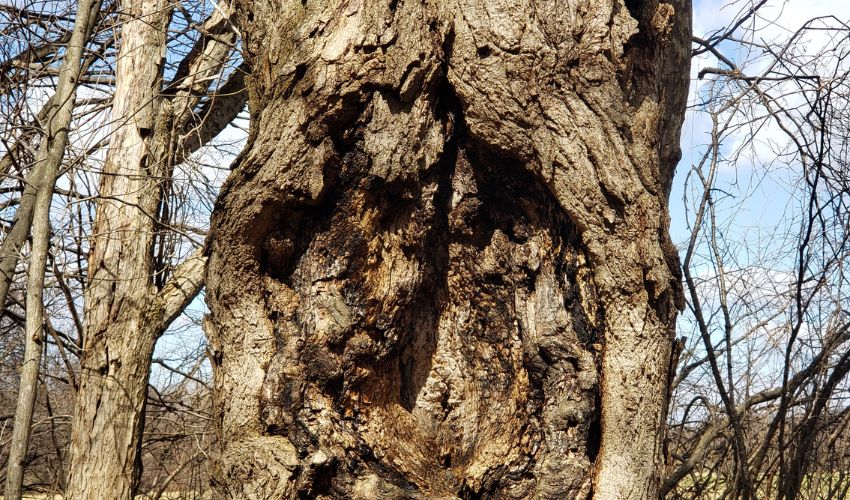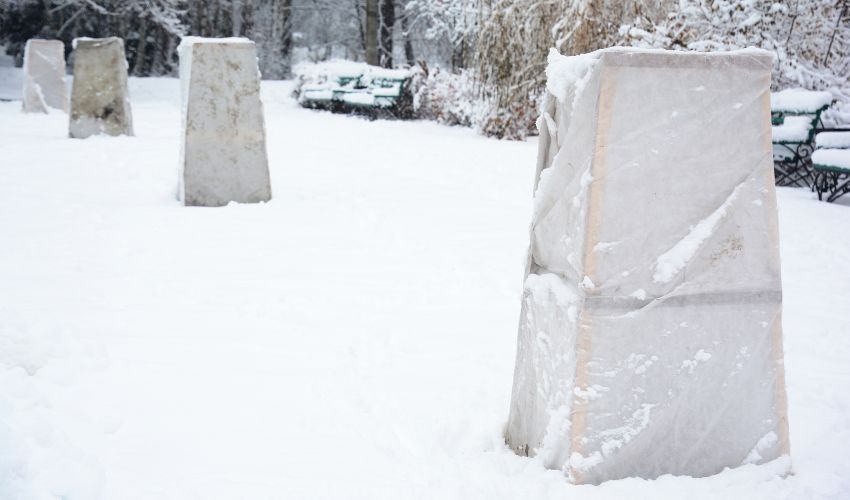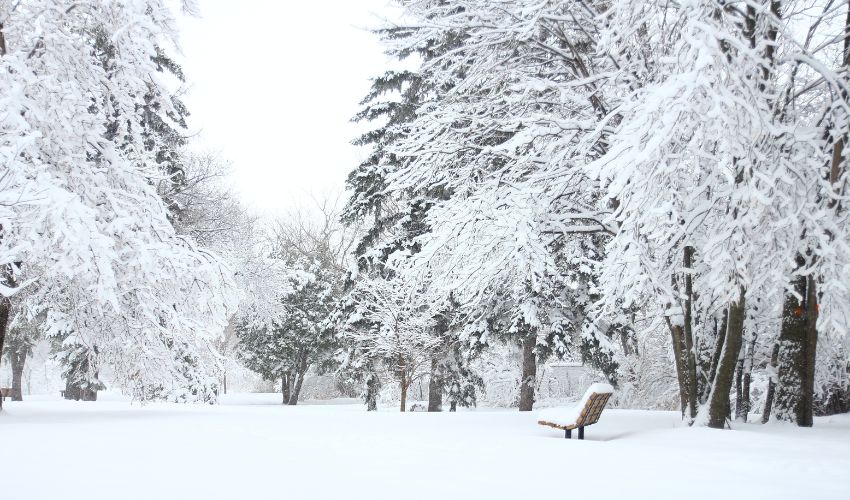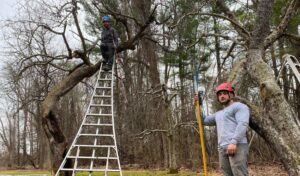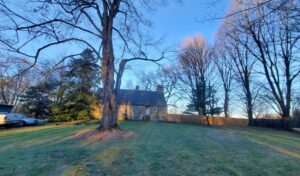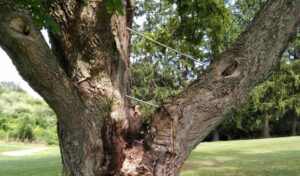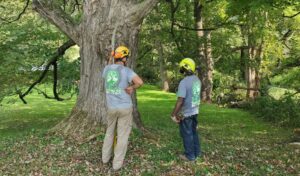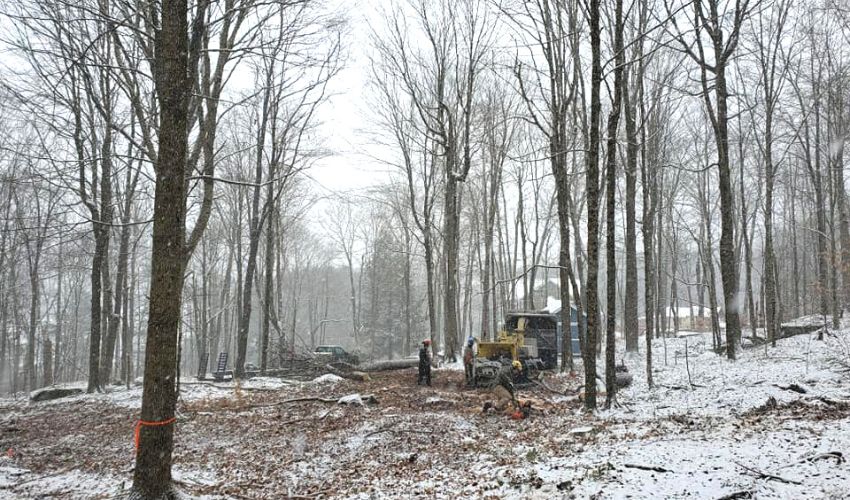
In New York’s Hudson Valley, our trees are up against a lot during the winter months, including winds, heavy snow, and bitterly cold temperatures. As we gear up for the season, it’s important to start taking steps now to care for your trees during these frosty months. We’ve compiled a handy checklist to help ensure your trees remain thriving and safe all winter.
Key Takeaways
- Thoroughly inspect your trees before winter weather arrives to identify any issues that could cause safety problems over winter.
- Consider pruning trees while they’re dormant.
- Install or check existing cables and braces in larger trees for added stability.
- Take measures to protect young trees or shrubs like building A-frame covers, wrapping them in burlap, and choosing eco-friendly road salt alternatives for de-icing.
- Regularly inspect trees for branch accumulation of snow and ice. Only remove excess snow (gently!) to prevent branch breakage if it’s absolutely necessary.
Getting Ready for Winter
Before the snow flies, here are some steps you can take to get your trees and shrubs ready.
Tree Inspection and Care
- Check for potentially unsafe branches or tree trunks with cracks or splits. If anything looks unsafe, it should be removed.
- Prune away dead or weak limbs that could fall under snow and ice weight.
- Trim back branches that are too close to buildings or power lines. Call us if you’re concerned about doing this safely. And never cut branches near power lines yourself unless you’re 100% certain that the power has been turned off.
- Clear away fallen leaves if you haven’t already, especially from trees like crabapples or dogwoods, which might have fallen leaves nearby carrying diseases like fire blight or anthracnose.
Mulching and Watering
- Apply a layer of mulch around the tree’s base to insulate the roots.
- Aim for a layer of mulch of about 2-4 inches.
- Keep the mulch a few inches from the trunk to prevent moisture buildup and potential rot.
- Water newly planted trees, shrubs, and plants thoroughly before the ground freezes.
Supporting Young or Fragile Trees
- Stake young or newly planted trees for additional support.
- Ornamental trees with thin bark and young or newly planted trees can be damaged by frost cracks and sunscalds. Protect them with trunk wrapping, such as burlap.
- Protect the base of young trees with wire mesh or tree guards to protect them from rodents chewing on them during the winter.
- Consider building A-frame covers over shrubs and young trees that could be damaged by falling snow, plowing, shoveling, etc.
Cabling and Bracing
- Have a Certified Arborist inspect your trees, particularly those near your home or power lines, to identify any at risk of breakage from heavy snow or ice. If necessary, install cables in larger trees for added stability.
- While your arborist is inspecting the tree, have them also check existing cables and braces, and repair or replace any that are loose or broken. This is definitely not a DIY job!
- Ensure all hardware is in good condition and properly adjusted.
- Install temporary or permanent supports (rope, cable, twine) for at-risk shrubs under snow and ice loads.
- Plan to remove these supports in the spring before growth starts.
Preparing Shrubs and Smaller Plants
- Use burlap screens to protect smaller plants from snow and salt spray from nearby roads. Burlap will also protect against deer browsing.
- If you haven’t done so already, clear away fallen leaves, particularly from shrubs that had insect infestations and/or diseases during the growing season.
- Salt used for de-icing can harm shrubs and plants, particularly sensitive species near heavily salted, high-traffic roads or in areas with poor drainage. On your property, consider using a less harmful salt alternative to salt.
Here’s a list of plants that deer love to eat, and what you might want to consider planting instead. You may also want to consider using deer repellent sprays.
Winter Pruning
When trees lose their leaves in fall, it’s easier to see the shape of your trees and identify dead or dangerous branches, making winter a prime time for pruning. Without leaves or flowers blocking the view, you can check for infections, dead or broken branches, insect issues, or other problems.
Avoid Pruning in Late Fall
- Avoid pruning your trees in late fall.
- Late-season pruning can stimulate new, fragile growth that’s susceptible to damage from early frosts and freezing temperatures.
Timing is Everything
- In many cases, the optimal time for pruning is after your trees have shed their leaves and are fully dormant.
- Winter pruning can also avoid spreading serious active diseases, such as Dutch elm disease, that spread easily during the spring and summer growing seasons.
- This timing allows for a quick recovery during spring.
- See our article for the best time to prune ornamental shrubs
Pruning Fruit Trees
- For fruit trees, late winter is the prime time for pruning.
- Proper pruning during this period can enhance fruit production and reduce the risk of fungal and parasitic infections.
Maintaining Tree Health All Winter
Despite the cold temperatures and harsh conditions, there are steps you can take to maintain tree health during the Hudson Valley winter.
- Inspecting your trees for structural issues throughout the winter is especially important. Problems like broken branches and split trunks can escalate quickly when combined with ice, snow, and wind. If you notice an issue, call the arborists at Hill Treekeepers to have it addressed immediately.
- Continue to water young trees during dry periods. If there has been a lack of precipitation, provide supplemental water to the root zone of your trees when temperatures are forecasted to be above freezing for a few days.
- Wet, heavy snow and ice can easily break tree branches. Avoid large amounts of snow accumulation on shrubs and trees by regularly (but gently!) removing snow after a significant snowfall.
- When clearing snow from branches, be sure not to break them. Gently brush the snow off with your hand or a broom, pushing softly upward and sweeping toward the tree trunk.
- Please don’t use a ladder or climb the tree; call us to take a look, and if necessary, we’ll remove the snow using the proper safety equipment.
- Take a close look at your hemlock trees during winter when they’re not covered by ice or snow to see if they’re infested by the hemlock woolly adelgid. If they are, call us to schedule a protective treatment.
Frequently Asked Questions About Winter Tree Care
Q. I need to have a tree removed. Should I wait until spring?
A. Winter is an ideal time for tree work because the ground is usually frozen, so bringing in heavy equipment is easier, minimizing damage to your lawn and often resulting in lower costs and faster work.
Q. What types of mulch are best for protecting trees and shrubs from cold weather in the Hudson Valley?
A. The best mulch types are organic materials like wood chips or straw. These mulches provide insulation, retain moisture, and protect tree roots from freezing temperatures and frost heaving.
Q. What should I do if my tree is damaged by snow or ice?
A. If you encounter damage that’s more serious than a slightly leaning small tree you can stake and brace on your own or a branch you can safely prune from the ground once the snow and ice have melted, it’s wise to contact a Certified Arborist for an assessment. Not all damage is evident from the ground.
Q. Can I plant a new tree during winter?
A. Good times to plant a tree are late winter/early spring before buds open, and late fall after the tree goes dormant but before the ground freezes. Planting at the right time of year will help your new tree establish itself well by giving it time to grow strong roots before the stresses of winter or summer.
Hill Treekeepers: Your Allies in Winter Tree Health and Safety
Winter tree care is vital for the health and safety of your trees and the protection of your property and loved ones. At Hill Treekeepers, our experienced team is here to ensure that your trees not only survive but thrive during the harsh winter months.
Don’t leave your trees to face the winter unprepared. Call Hill Treekeepers today at 914-214-7045 for a professional assessment and tailored winter care plan. Let us take the worry out of winter for you, ensuring your trees are healthy, safe, and beautiful. Reach out now to secure the well-being of your trees and peace of mind this winter season.
Share this online!
Get the highest quality of tree services for residential and commercial properties in the Hudson Valley area. We look forward to working with you!
TOPICS
Recent Articles
Don't Miss the Next Update!
Join the thousands of smart Hudson Valley residents who get the monthly newsletter from Hill Treekeepers. It's full of helpful information you won't want to miss!

